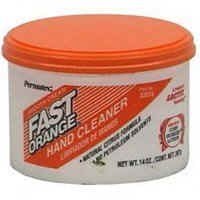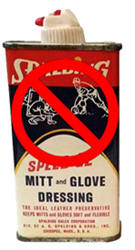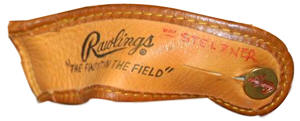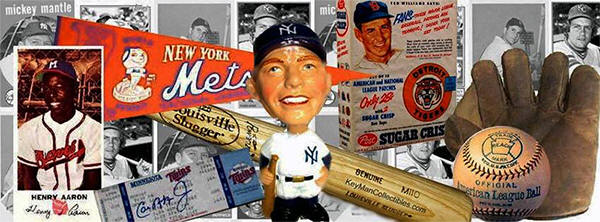Cleaning and conditioning your
collectible baseball glove or mitt,
will help bring the leather back to
life, make a better display, and
add value. This is a popular discussion
among novice and seasoned glove
collectors. The opinions will vary
from one collector to another on
preferred methods and which products
to use. My advice is not to take on
a project that is well above your
experience.
The restoration of any collectible should be left to
the expert that has experience with
that type of work. Extreme methods
such as stripping and dying the
leather should be avoided. Start
off with basic cleaning &
conditioning methods with
inexpensive baseball gloves until
you gain enough skill to move on to
the
advanced products for use on more
expensive glove models. Always
experiment cleaning obscure parts
of the glove first, and always be
studious of the work you are doing.
For the most part it is believed that leather cleaners and conditioners
can be rubbed into leather by just
about anything in a laundry basket.
While this is relatively true, it’s
not the best way to do it. Some
"rags" or clothes have

abrasive and
lint-ridden qualities that might
not do the job as well. Use the correct tools for any job.
Microfiber and terry cloth come highly recommended for use on cleaning and
conditioning leather. Microfiber
cloths are a synthetic material
made up of tiny strands. Each
strand is about 1% the diameter of
a human hair and can be tightly
woven to to form a soft, silky
cloth with remarkable durability,
absorption and filtering capacity.
In addition, it’s pretty
lightweight, and has an almost magnetic
attraction to dust.
Terry cloth, has been around a lot longer, and does have unique qualities
that make it highly recommend as
well. Both of these fabrics clearly
have their strong points. Which
leather conditioner applicator you
should use depends on your type of
leather and how you’re going to use
it. For the most part both will
safely do the job on any type of
leather and only through experience
of use will you learn the best for
your project.
Before conditioning your glove it would be a good idea to clean it first.
Even if you feel the glove is not
dirty, removing any minor surface
dirt will prepare the leather to
fully absorb what ever conditioning
you use.
To
safely clean the glove you could
use a gentle leather cleaner like
Lexol-pH Leather Cleaner, or Nokona
Glove Conditioner which gives a
nice glow to the leather once it's
clean. Permatex Fast Orange Smooth
formula Hand Cleaner comes highly
recommended by hardcore Glove
collectors, and restorers.
once it's
clean. Permatex Fast Orange Smooth
formula Hand Cleaner comes highly
recommended by hardcore Glove
collectors, and restorers.
Permatex Fast Orange can be found at Lowes Home Improvement Stores,
AutoZone, K-Mart or your local
hardware store. It can also be
purchased on line. Be sure to
purchase the Smooth formula, and
not with pumice which is abrasive,
and will harm the leather. Permatex
Fast Orange will clean the grime
from the glove. The contents list
lanolin as an ingredient so that is
a plus in helping to keep the glove
supple. As with most cleaning
products you use it will also dry
out the leather a bit after use so
apply conditioning shortly after
cleaning.

Conventional glove oils sold over the counter is fine for a glove we are
going to work in to play ball with.
Some of these oils will most likely
darken the color of the glove, and
could leave oil spots. These oils,
especially if over applied could
clog the pores of the leather and
actually shorten the life of the
leather. For a
collectible glove which will be
displayed we want to avoid any of this.
There are a number of different
products you could use to condition
the glove. Some are listed in the
Vintage Baseball Glove Cleaning and
Conditioning Guide on the
website. Horseman's One step is
growing in popularity, and can be
used for both cleaning and
conditioning.
A "Rule of Thumb" is to never use anything on your glove that you would
not use on your hands. If the glove
you're working on is very dry, and
stiff, I've found it's actually
best to start with the interior of
the glove. Go way up inside the
fingers with a toothbrush, on all surfaces, behind the
wrist strap and under any folds
that might go overlooked. Doing
this step first lets you put the
glove on to do the rest. Then go to
the back of the glove, between the
fingers, and then finally the
pocket and the rest of the front
surface.
Repeat applications as needed. This will only serve to make the leather
cleaner and healthier. For old
grease stains it helps to scrub it
in with an old toothbrush, then
wipe the lifted grease away. Most
products will soften ink stains,
but not remove them completely in
all instances. This is another
subject of great discussion. The
removal of inked in names.
Names written with Magic
Marker and Sharpie are permanent
and tougher to remove or lighten
than ballpoint ink and felt tip
markers. I have read many
suggestions that include the use of
a toothbrush with Murphy’s Oil
Soap, and Motsenbocker, Lift Off #3
Pen, Ink & Marker/Graffiti Remover.
A futile attempt in the removal
of inked in names can

leave the the leather looking
bleached, and Blotchy
My recommendation is, unless the name is a total eye sore, leave well
enough alone and let it be. You could
make it look a lot worse. Besides,
most names
are written on the back or side of
the glove where it cannot be seen
when displayed.
If you want to take the next step up in extreme glove restoration,
cleaning and conditioning, you
might want to join a
Vintage Baseball Glove Forum
that will feature posts from
advanced glove collectors. You will
also find many websites online that
will educated you on the cleaning,
conditioning, and preservation of
leather. Sites that deal in
leather goods such as saddles,
clothing or furniture.


